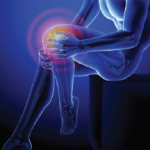Researchers do know common risk factors for OA, though. The disease is initiated and propagated because of both endogenous risk factors, such as age and genetics, and environmental risk factors, such as being overweight or sustaining a knee injury. Dr. Englund’s presentation focused on the two most common environmental risk factors that lead to old knees on young adults: knee injury from damage to the anterior cruciate ligament (ACL) and knee injury from damage to the meniscus. He presented results of research published in Arthritis & Rheumatism that shed new light on the pain associated with meniscal tears.1
Tears to the menisci are commonly found on MRI images and are related to aging, obesity, and athletic injuries. “If I were to extrapolate data, there are today about 5 million U.S. adults age 50 and above that have a meniscal tear,” says Dr. Englund. Patients with these tears sometimes feel pain. But before Dr. Englund’s research, nobody knew if the tears actually caused the pain, or if it came from a different source, such as OA.
In this prospective Multicenter Osteoarthritis Study, Dr. Englund and his colleagues recruited 3,026 individuals aged 50 to 79 who had a high risk of developing osteoarthritis of the knee. One hundred ten case knees were chosen randomly from those patients who did develop symptoms in 15 months; 220 control knees were chosen from the patients who did not develop symptoms. An independent panel of radiologists compared the MRI images of both groups at baseline and at 15 months to see if pain symptoms correlated with damage to the meniscus.
At baseline, 38% of case knees and 29% of control knees had meniscal damage, with a higher frequency among women. The researchers also found that the degree of meniscal damage did correlate slightly with the development of knee pain and stiffness. However, after a thorough statistical analysis, the researchers found no independent association between the degree of meniscal tearing and the development of pain symptoms.
Dr. Englund theorizes that because OA almost always accompanied meniscal tears, it’s conceivable that the OA causes the pain symptoms.
Advantages of Exercise
In her presentation, Dr. Roos discussed the role of exercise in the prevention of knee OA in middle-aged patients. “We have known for quite some years now that exercise is actually evidence-based medicine for patients with knee OA to reduce pain and improve physical function,” she says.
In another study from Arthritis & Rheumatism, Dr. Roos and Leif Dahlberg, MD, of Lund University Hospital in Lund, Sweden, showed how moderate exercise can strengthen joint cartilage in middle-aged patients at risk of OA.2 They studied 45 patients aged 35–50 who had undergone meniscus repair within the past three to five years. Half of these subjects were used as controls; the other half went into a supervised exercise program three times a week. After four months, MRIs of all subjects were compared for cartilage glycosaminoglycan (GAG) content, a good measure of strength and elasticity.


